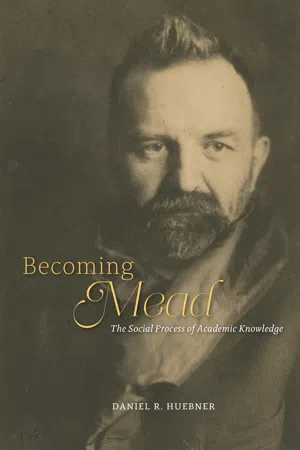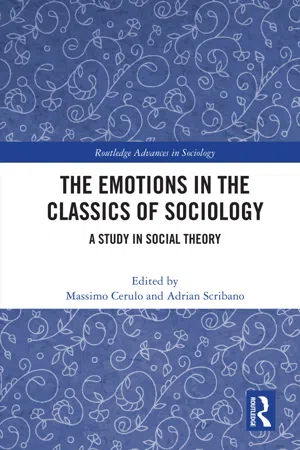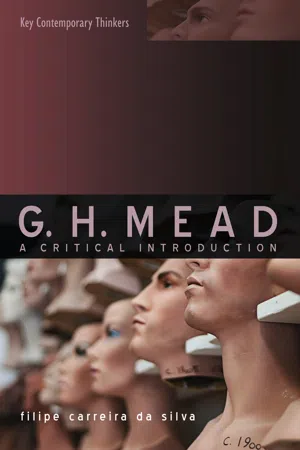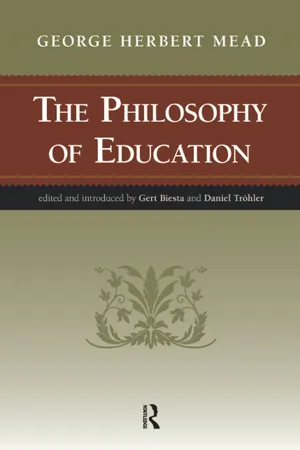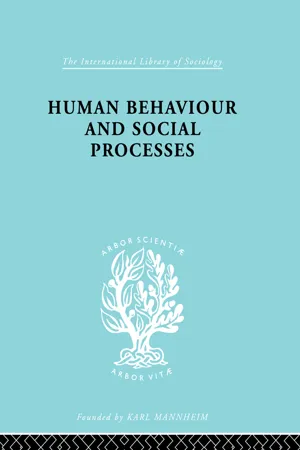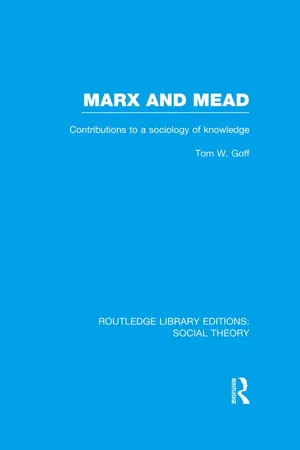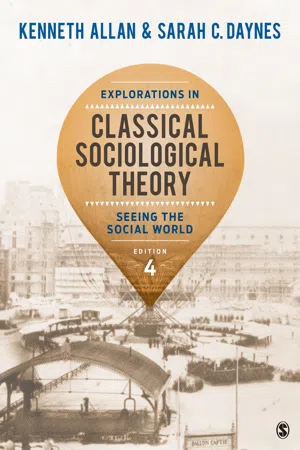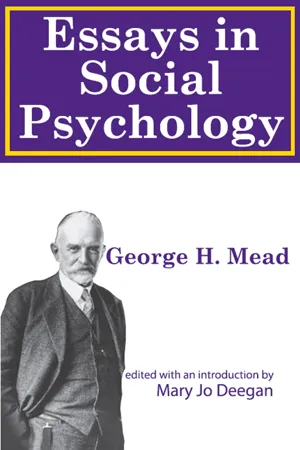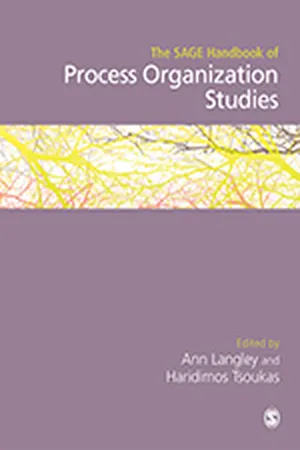Social Sciences
George H. Mead
George H. Mead was an influential American philosopher and sociologist known for his contributions to the field of symbolic interactionism. He emphasized the role of social interaction and communication in shaping individual identity and behavior. Mead's work laid the foundation for understanding the self as a product of social processes and the importance of language and symbols in human interaction.
Written by Perlego with AI-assistance
Related key terms
12 Key excerpts on "George H. Mead"
- eBook - ePub
Becoming Mead
The Social Process of Academic Knowledge
- Daniel R. Huebner(Author)
- 2014(Publication Date)
- University of Chicago Press(Publisher)
This conceptual formulation provides the connecting link between the disparate parts of the study, integrating them into a single processual account. And it allows the case study simultaneously to develop a thoroughly inductive empirical inquiry and to be consonant with a productive theory of social action. Theory informs the modes of inquiry at the same time that the narrative displays the empirical features of the case. The implications of these issues are developed in the section on the practical considerations resulting from the theoretical discussion. The methods of data collection and examination are then detailed, beginning with a discussion of the ways in which historical documentation can contribute to understandings of social action. The major types of archival and primary document research utilized in the study are enumerated and some consideration is given to the conscientious examination of the data that come from such research. Finally, I outline the basic progression of the substantive chapters and conclusion as a way of cuing the reader in to the overall structure of the study and some of its key arguments.MEAD AS A PROBLEM OF KNOWLEDGEGeorge Herbert Mead is problematic. It is in sociology, more than in any other discipline, that Mead is treated as an important theoretical resource and as a foundational figure, where he is known primarily for his theory of the social nature and genesis of the self, as the quintessential forerunner of the Symbolic Interactionist perspective, and as a central theoretical resource for the Chicago School of sociology. This is despite the fact that he was a philosopher who never taught a course primarily listed in sociology, and who taught and wrote about a wide variety of topics far outside of the concerns for which he is predominately remembered, including experimental and comparative psychology, the history of science, and relativity theory. Indeed, although his longtime colleague and friend John Dewey (1931, 310) memorialized Mead as “the most original mind in philosophy” of his generation, he has never had anywhere near as high a profile among philosophers as did other intellectuals of this generation, including Dewey. Much of the following study is directed to these problems, but it is worth underscoring at the outset the seemingly enormous gap between a dominant foundational “myth” of Mead and the actual historical person who lived and acted day to day.The work by which he is overwhelmingly known and for which he is cited is Mind, Self, and Society: From the Standpoint of a Social Behaviorist (1934). This book was one of several put together after his death, primarily from notes taken by stenographers and students in his courses and from unpublished manuscripts, as a way of preserving a published legacy to Mead and of systematizing his philosophy. As the former students and junior colleagues who compiled the materials noted at the time, there was no indication that Mead would have intended such materials for print, and he surely never sought the publication of such materials in life. These posthumous volumes have been controversial since they were published, and Mind, Self, and Society in particular has been subjected to a long history of criticism for the seemingly idiosyncratic view it gives of Mead’s philosophy and the rather unclear authorial status of much of the text. Nevertheless, Mind, Self, and Society - eBook - ePub
The Emotions in the Classics of Sociology
A Study in Social Theory
- Massimo Cerulo, Adrian Scribano, Massimo Cerulo, Adrian Scribano(Authors)
- 2021(Publication Date)
- Routledge(Publisher)
Chapter 9 George Herbert Mead Lorenzo Bruni9.1 Introduction
George Herbert Mead (1863–1931) can be considered, for all intents and purposes, as a classic of sociological thought. This affirmation is not universally shared. Indeed, Mead is often defined primarily as a psychologist or a philosopher, and his standing as a sociologist has not always been accepted. Mead’s elevation to the canon as one of the leading lights of sociology has come about in two fundamental stages. Herbert Blumer and Jürgen Habermas are the two thinkers whose interpretive work has made the greatest contribution to Mead’s status as a sociological institution (see Côté, 2016 ; Huebner, 2014 ; Carreira da Silva, 2006 ).Blumer was the first to promote Mead’s canonization within the discipline of sociology (Blumer, 1981 ; 1969 ). The reception of Mead’s work on the part of the founder of symbolic interactionism is credited with laying the groundwork for the legitimization of Mead’s thought in the disciplinary field of sociology, providing the impulse for a substantial program of empirical research (see Carreira da Silva, 2006 ). Mead’s elevation to the status of an institutional figure in sociology was definitively certified by Jürgen Habermas and by the central role that he attributes to Mead in The Theory of Communicative Action (1987). Habermas, as is well known, makes ample reference to Meadian theory with the aim of formulating a sociological hypothesis on the social solidarity between strangers in the transition from a prevailing model of goal-orientated strategic action to a model of communicative action. The German sociologist credits Mead with being the sole artificer of a symbolically mediated theory of social interaction.Mead’s reflections on emotions are distinguished from other classic sociological formulations by one peculiarity. Like other sociologists, Mead believes that emotions are exquisitely social. But the characteristic feature of his conception is his proposal of a singular definition of the social dimension of emotions. For Mead, emotions are the raw material for the cognitive development of intersubjective human relations. Emotions constitute a sort of connective fabric, social in origin, between a dimension of feeling and a more cognitive dimension determined by human behaviour. - eBook - ePub
G.H. Mead
A Critical Introduction
- Filipe Carreira da Silva(Author)
- 2013(Publication Date)
- Polity(Publisher)
1 Introduction and General OverviewA century has passed since George Herbert Mead (1863–1931) started working on the social theory that would grant him a place in the sociological canon, and yet his writings have lost none of their appeal. The reason why Mead’s ideas are after all these years still so engaging is, I argue, that the last two fins de siècle share certain structural similarities. Very much as in Mead’s time, Western modernity is experiencing today a sense of profound crisis, which follows a relatively long period of confidence in the rational mastery of social problems. In such epochs of crisis, the best theoretical instruments are those able to deal with change, uncertainty and hybridism. From this perspective, I think we have a lot to learn from Mead, perhaps the sociological classic who (with Simmel) best responded to the conceptual challenges posed by the first crisis of Western modernity. Rejecting the pessimism one can find in other classics’ writings (just recall Weber’s theses on bureaucratization or on the disenchantment of the modern world), Mead was confident that science and democracy could be reconciled in the form of a naturalistic and evolutionary social science, which conceives of the human mind as an ‘emergent’ from – that is, an entity resulting from – symbolic interaction.Among the sociological classics, Mead occupies a special position. Although he lived in the same epoch as all the other ‘founding fathers’ of sociology (he was five years younger than Durkheim and one year older than Weber), he is not only one of the few to have exerted a profound and lasting influence on a discipline other than his own, but also the only American to figure in that canonical gallery. In fact, Mead was not a sociologist; he was, by training, a philosopher with a strong interest in social psychology. The brilliance of his ideas on the social nature of the human self, however, ensured that in disciplines such as sociology and social psychology Mead is still seen today as one of the predecessors of their greatest practitioners. Unlike Marx, Weber or Durkheim, Mead was not a prolific writer. It was in the classroom, thinking aloud in the silent presence of his students, that Mead was at his best. This personal preference for the spoken word is very much in accord with the always ‘in-the-making’ nature of his intellectual edifice. Far from being a rigid, all-encompassing philosophical system, Mead’s thinking is best described as a system in a state of flux. - eBook - ePub
- E.C. Cuff, W.W. Sharrock, D.W. Framcis, A.J. Dennis, D.W. Francis(Authors)
- 2015(Publication Date)
- Routledge(Publisher)
Cartesian dualism) that the human being was composed of two distinct elements, the mind and the body, which had to be understood separately. Mead set himself against the traditional dualism and, equally, against the idea that the mind is a purely individual phenomenon.Mead's view of the self
The human mind – which Mead termed the self – develops in and through the process of symbolic interaction, enabling an individual to acquire a sense of himself or herself as an individual.The development of the human mind was to be understood in strictly Darwinian terms as a product of the evolutionary process; the evolution of the human organism and the social nature of human individuals were both part of their biological nature. Hence Mead was certainly confident that social life could be studied scientifically, since his social psychology was in essence an application of biology, but he was none the less critical of many attempts to understand human social life scientifically. This was not because they sought to be scientific, but because they had an impoverished conception of:- what science involves (the methods); and/or
- what the science is to study (the subject matter) in the case of human life.
The capacity of humans to respond in a more complex and flexible way to their environment than other animals is a product of human biology and its evolution into its specific form. For example, no small part of the crucial linguistic/symbolic capacity of humans is a result of the evolution of the vocal cords. Mead emphasises the contrast between the way animal response is tied to the immediate situation and the way humans can transcend it; they are able to reflect upon and respond to past situations well after they have occurred, and can anticipate and prepare for future situations before they happen. How we shall react in a situation can depend on our preparation and planning, not just on an automatic link between a certain occurrence and a fixed, instinctual reaction as in the case of a reflex action, e.g. the knee’s reaction on being hit. We do have reflex reactions, but not only those. Thus Mead is putting the case that we ourselves can control our own behaviour; we do not simply react to a stimulus that provokes our reaction. - eBook - ePub
- George Herbert Mead, Gert Biesta, Daniel Trohler(Authors)
- 2015(Publication Date)
- Routledge(Publisher)
Introduction
George Herbert Mead and the Development of a Social Conception of Education Gert Biesta and Daniel TröhlerDOI: 10.4324/9781315632834-1George Herbert Mead was born on February 27, 1863, in South Hadley, Massachusetts. From 1869 onwards he lived in Oberlin, Ohio, where his father, a Congregational minister, was a professor at Oberlin Theological Seminary. In 1883 Mead graduated from Oberlin College. For the next four years he worked as a teacher, railroad surveyor, and private tutor before he moved to Harvard in 1887 to study philosophy with, among others, Josiah Royce. One year later Mead enrolled at the University of Leipzig where he studied philosophy with Wilhelm Wundt, Max Heinze, and Rudolf Seydel. Early in 1889 he moved on to the University of Berlin, where he studied philosophy, psychology, and education with, among others, Hermann Ebbinghaus, Wilhelm Dilthey, and Friedrich Paulsen. In 1891, before he managed to finish his Ph.D., Mead returned to the United States to take up a teaching position at the Department of Philosophy of the University of Michigan, Ann Arbor, where he worked under the chairmanship of John Dewey. In 1894 , Mead moved with Dewey to the University of Chicago, where he would continue to work until his death on April 26, 1931.Together with Charles S. Peirce, William James, and John Dewey, Mead is one of the founders of American pragmatism. Whereas Dewey and, to a lesser extent, James had a major impact on the theory and practice of education, Mead is most renowned for his work in philosophy and social psychology, particularly as the main source of inspiration for symbolic interactionism—the label Herbert Blumer gave to Mead’s work (Blumer 1969 ; Joas 1989 , 235). Mead did, however, have a practical interest in education which was stimulated by his collaboration with Dewey at the University of Chicago and which was part of his wider involvement in social reform in Chicago in the first decades of the twentieth century (Barry 1968 ; Cook 1993 ). Mead’s only son was enrolled in Dewey’s Laboratory School and for several years Mead served as president of the school’s Parents’ Association (Mead 1903 ). With his wife, Helen Castle, Mead edited Dewey’s lectures on the school, which were published in 1900 as The School and Society (Dewey [1900 ] 1976). Mead also contributed to two educational journals, School Review (Mead 1907 a) and Elementary School Teacher, of which he was an editorial board member from 1907–1909 (Mead 1907 –1908a; 1907–1908b ; 1908–1909b ; 1908–1909c ; 1908–1909d ; 1908–1909e ). From 1908 until 1914, Mead served as chairman of the Standing Committee on Public Education of the City Club of Chicago (Mead 1912 a). In this role he was actively involved in the writing of reports on the Chicago public library system, on vocational education in the Chicago public school system, and on the funding and administration of vocational education in the public schools of the state of Illinois (Mead, Wreidt, and Bogan 1912 - eBook - ePub
- Anthony Forder, Terry Caslin, Geoffrey Ponton, Sandra Walklate(Authors)
- 2018(Publication Date)
- Routledge(Publisher)
The philosophy of pragmatism and the oral tradition generated a way of analysing human social behaviour in the first half of the twentieth century which was qualitatively different from the predominant view. In the post-war period this influenced a generation of sociologists, enabling them to question the accepted ways of conducting research and understanding individual action. The ideas responsible for this are to be considered, in the first instance by reference to the work of Charles Horton Cooley and George Herbert Mead.CHARLES HORTON COOLEY (1864-1924); GEORGE HERBERT MEAD (1863-1931)
Influenced by James and Darwin, the evolutionist, Cooley developed his own distinctive contribution to the interactionist perspective through the concept of the ‘looking-glass self’. For Cooley, the individual does not exist in isolation but can only exist through communication with others; there is no separation of the individual from the social, they exist in a dialectical relationship with each other. Hence the self is a looking-glass self because it emerges in the individual’s consciousness through communication with others. Cooley was essentially concerned with the process whereby the human personality emerged and thus he became concerned with the role of the ‘primary group’ and its effects.Similarly Mead, influenced by James and in some ways paralleling the work of Cooley, was concerned with the role of the consciousness in the formation of the self. Reputedly an excellent lecturer. Mead published little, and yet he has since become the more influential thinker in the tradition of interactionism. More of a philosopher than a sociologist, he spent most of his intellectual life at the University of Chicago, where, interestingly, he was a contemporary of the behaviourist, J.B. Watson, with whom, some of his ideas suggest, he was in dialogue. There are several themes underlying the work of Mead, in particular the notions of continuity and flux and the emergent nature of man. These are reflected in his basic concepts of interaction, socialisation, self and mind.In considering interaction. Mead wished to make a distinction between what he called ‘human’ and ‘non-human’ interaction. Non-human interaction comprised what Mead called the ‘conversation of gestures’. These gestures do not constitute subjectively meaningful actions but are rather patterns of communication controlled by innate release mechanisms. So, he argues, animals do not engage in conscious reflection about their actions. As far as human action is concerned, Mead considered the capacity for interaction to be the highest of a series of levels of action which may be correlated with movement along the evolutionary scale in the Darwinian sense. The simplest species are capable of simple reactivity only, e.g. moving away from something which burns. At the next level it is possible to discern a more complex stimulus response chain, for example, Pavlov’s dogs or Thorndike’s cats. Higher primates reflect the capacity for relational responses, identifying cause and effect, shown in the ability to use tools and solve practical problems in this way. Only human beings have reached the fourth level of response, which releases them from the stimulus-response chain of the behaviourists. Man, he argues, does not observe the world directly but sees it in terms of labels which have symbolic meaning for him, i.e. an interpreted world. Man, the only species capable of all four levels of response, is a biological animal freed from the deterministic impulses of his biology and his environment by his ability to acquire and understand the symbols of the social world into which he is born, i.e. his language. - eBook - ePub
Human Behavior and Social Processes
An Interactionist Approach
- Arnold M. Rose(Author)
- 2013(Publication Date)
- Routledge(Publisher)
A view of human society as symbolic interaction has been followed more than it has been formulated. Partial, usually fragmentary, statements of it are to be found in the writings of a number of eminent scholars, some inside the field of sociology and some outside. Among the former we may note such scholars as Charles Horton Cooley, W. I. Thomas, Robert E. Park, E. W. Burgess, Florian Znaniecki, Ellsworth Faris, and James Mickel Williams. Among those outside the discipline we may note William James, John Dewey, and George Herbert Mead. None of these scholars, in my judgment, has presented a systematic statement of the nature of human group life from the standpoint of symbolic interaction. Mead stands out among all of them in laying bare the fundamental premises of the approach, yet he did little to develop its methodological implications for sociological study. Students who seek to depict the position of symbolic interaction may easily give different pictures of it. What I have to present should be regarded as my personal version. My aim is to present the basic premises of the point of view and to develop their methodological consequences for the study of human group life.The term “symbolic interaction” refers, of course, to the peculiar and distinctive character of interaction as it takes place between human beings. The peculiarity consists in the fact that human beings interpret or “define” each other’s actions instead of merely reacting to each other’s actions. Their “response” is not made directly to the actions of one another but instead is based on the meaning which they attach to such actions. Thus, human interaction is mediated by the use of symbols, by interpretation, or by ascertaining the meaning of one another’s actions. This mediation is equivalent to inserting a process of interpretation between stimulus and response in the case of human behavior.The simple recognition that human beings interpret each other’s actions as the means of acting toward one another has permeated the thought and writings of many scholars of human conduct and of human group life. Yet few of them have endeavored to analyze what such interpretation implies about the nature of the human being or about the nature of human association. They are usually content with a mere recognition that “interpretation” should be caught by the student, or with a simple realization that symbols, such as cultural norms or values, must be introduced into their analyses. Only G. H. Mead, in my judgment, has sought to think through what the act of interpretation implies for an understanding of the human being, human action, and human association. The essentials of his analysis are so penetrating and profound and so important for an understanding of human group life that I wish to spell them out, even though briefly. - eBook - ePub
Marx and Mead
Contributions to a Sociology of Knowledge
- Tom Goff(Author)
- 2014(Publication Date)
- Routledge(Publisher)
129 He comprehends the truth of the results of scientific work as precisely the functional relationship of reconstructions to the needs of man as a social being. The predictive aspect of science is always temporally limited and contingent.IMPLICATIONS FOR INTERPRETATION OF THE SOCIAL THEORY OF MANThe criticisms of Mead’s theory of the development of mind and self, as that theory is presented in Mind, Self and Society , can be viewed as a refutation of the adequacy of his attempt to develop a synthesis of positivistic and idealist theories of human life. These criticisms concentrate on two specific issues. Briefly, it was shown that Mead’s introduction of the ‘I’ aspect of the self is not consistent with, nor logically integral to, his theory of self and mind as arising through an internalization of the prior, on-going social process in the form of conscious attitudes. The ‘I’ is considered as a residual category that is not explained within the theory of socialization, and is largely spoken of in terms of ‘chance’; the unexpected aspect of the actual response of the organism to the situation. Without the necessary elaboration, the individual is reducible, without contradiction, to the ‘me’ aspect of the self, to the internalized meanings present in his situation. Mead is quite clear in arguing that the self is continually undergoing change, but this is predicated strictly on changing responses of others and things to the specific individual.Second, it was demonstrated that the social process, out of which self and mind emerge is, in turn, reducible to a specific and predictable idea of an evolutionary process in nature. Mead clearly expresses the view, especially in the chapter entitled ‘Society’, that human history is an almost automatic expansion of universality; the gradual realization of a global community of common and shared attitudes, characterized by democratic government and a high development of functional social differentiation and interdependence. In fact, he argues that this predicted future follows precisely from the social-behaviouristic theory of mind and self that he develops, and that this future is indeed being realized. - Buford Rhea(Author)
- 2020(Publication Date)
- Routledge(Publisher)
7 George Herbert Mead HERBERT BLUMERThe decision to include a presentation of the thought of George Herbert Mead in a volume devoted to the future of sociological classics is both generous and foresightful. It is generous in that Mead’s thought cannot be said to have yet gained acceptance comparable with that of such figures as Comte, Durkheim, Weber, or Simmel. Mead’s thought, at best, has been lodged at the periphery of sociological concern. While a relatively small number of sociologists have sustained and fostered his views with vigor, the majority have given his thought a merely courteous nod of distant acquaintance. As happens so frequently in such circumstances remote acquaintance leads to inadequate comprehension, which here takes the form of a few stereotyped characterizations, such as that Mead’s thought is philosophical and not scientific, or that it deals only with the individual and not the group, or that it is ‘microsociological’ and not ‘macro-sociological’, or that it is a form of social psychology and not a form of sociology, or that it is merely a variant of phenomenology, or that it shortsightedly rejects the idea of social structure, or that it lacks any devices for the study of group life. It is not surprising that in being characterized in these ways Mead’s scheme of thought has been slighted by most sociologists as not worthy of serious consideration. For many sociologists Mead is a remote figure. For many other sociologists, especially non-American sociologists, Mead is an unknown figure. To include him among the present set of classical sociological figures might thus be seen as a charitable act.Yet, in my opinion, the decision to include Mead’s scheme of thought in the present volume is foresightful. There are strong prospects that his thought will attract increasing interest and adherence because of the distinctive way in which it ties together individual action and group life. Mead’s scheme centers on a picture of the human being which is quite different from that at the basis of the classical sociological approaches. Further, his picture of the human being as a participant in group life stands up exceptionally well when subjected to the rigors of empirical testing. This combination of uniqueness of perspective and of empirical validation appears to be bringing about increasingly serious consideration of Mead’s approach. With a better understanding of that approach there is good reason to expect that Mead’s scheme will come to occupy a recognized place in the standard body of sociological thought.1- eBook - ePub
Explorations in Classical Sociological Theory
Seeing the Social World
- Kenneth Allan, Sarah Daynes(Authors)
- 2016(Publication Date)
- SAGE Publications, Inc(Publisher)
It’s an internal conversation or symbolic interaction between the I and the Me through which we arrive at the meaning and evaluation we will give to our own behaviors, thoughts, and feelings, which we then thread together into a story we tell ourselves and others about who we are (the meaning of this particular social object). The self is initially created through successive stages of role taking and the internalization of language. This emphasis of Mead’s (1934) leads him to see society and social institutions as “nothing but an organization of attitudes which we all carry in us”; they are “organized forms of group or social activity—forms so organized that the individual members of society can act adequately and socially by taking the attitudes of others toward these activities” (pp. 211, 261–262). Society, then, doesn’t exist objectively outside the concrete interactions of people, as Durkheim or Marx would have it. Rather, society exists only as sets of attitudes, symbols, and imaginations that people may or may not use and modify in an interaction. In other words, society exists only as sets of potential generalized others with which we can role-take. The I and the Me Thus far, it would appear that the self is to be conceived of as a simple reflection of the society around it. But for Mead, the self isn’t merely this social robot; the self is an active process. Part of what we mean by the self is an internalized conversation, and by necessity interactions require more than one person. Mead thus postulates the existence of two interactive facets of the self: the I and the Me. The Me is the self that results from the progressive stages of role taking and is the perspective that we assume to view and analyze our own behaviors. The I is that part of the self that is unsocialized and spontaneous: “The self is essentially a social process going on with these two distinguishable phases - eBook - ePub
- George Mead(Author)
- 2017(Publication Date)
- Routledge(Publisher)
Mead found that, like his own former teacher Royce, Baldwin also underestimated the significance of sociality or the social impulse in human behavior (see chapter 2 here). James, Cooley (1902), and Angell, however, had a conception of the self and the other that were closer to Mead’s. Mead, nonetheless, found Wundt’s definition of the gesture as a segment of vocalization and language to be a critical insight. Mead believed that “the other” generates meaning and values for an act which then creates an attitude. Acts gain meaning when they call out a response in the other where “thought” is a form of subliminated conversation. The social group, in turn, structures consciousness. All these ideas received further development in Mead’s mature social psychology. At this point in his career, nonetheless, Mead still viewed social psychology as a counterpart to physiological psychology, a close association he ultimately discontinued. Mead viewed consciousness as an independent factor within the individual and not just a phase within a larger, general process (see chapter 3 here). Mead calls his perspective “functional psychology” and links it to his work in “The Definition of the Psychical,” (1903). 16 Functional psychology examined the purposive character of conscious processes that emerged form a new evolutionary development. Consciousness was a phase of reality and not an island connected to physiological responses and stimuli. The selves of others, moreover, exist for the individual because they are social objects with similar experiences. Since the self and the other emerge from similar social processes, this creates intersubjective understanding. Again, Mead emphasized Wundt’s concept of the gesture as part of a shared social process - Ann Langley, Haridimos Tsoukas(Authors)
- 2016(Publication Date)
- SAGE Publications Ltd(Publisher)
What distinguishes the human being from other living forms is its capacity to act reflectively, to identify ‘this as leading to that’ and to use symbols to indicate the implication to others and oneself in order to make possible the control of conduct with reference to it (Mead, 1934: 120). The meaning of these symbols is created through interactions in the context of a social, cooperative act, which for Mead is the ‘unit of existence’ in human experience (Mead, 1938: 66). He maintained that ‘the behavior of an individual can be understood only in terms of the behavior of the whole social group of which he is a member’ (p. 6). In this way, Mead laid the foundation of a process theory of identity formation, and by embracing an intersubjective perspective, he broke with the prevailing idea of his time that social psychology could be based on the individual subject (Joas and Knobl, 2009).The process of exercising intelligence becomes possible through the mechanism of the central nervous system, which enables the individual to become an object to himself or herself, and thereby develop a self, and with a self, a mind. Mead's analysis of the emergence of self exemplifies a process-relational approach to the study of human conduct. The self is not present at birth as a result of biological development but emerges, evolves, and is maintained through processes of social interaction. The self-object emerges from interaction in the context of cooperative activity, as the individual takes the roles or attitudes of others – that is, by placing oneself in the position of others and viewing or acting toward oneself from that position (Mead, 1934: 141). ‘Taking the role of the other’ refers to anticipating others’ behaviors, something that enables social organization and coordination and the alignment of individual actions (Blumer, 1969; Joas, 1997). To the extent this happens, others’ behaviors with respect to the larger social process in which they are commonly involved as a group ‘are brought within the individual's field of direct experience and are included as elements in the structure or constitution of his self’ (Mead, 1934: 158).
Learn about this page
Index pages curate the most relevant extracts from our library of academic textbooks. They’ve been created using an in-house natural language model (NLM), each adding context and meaning to key research topics.
